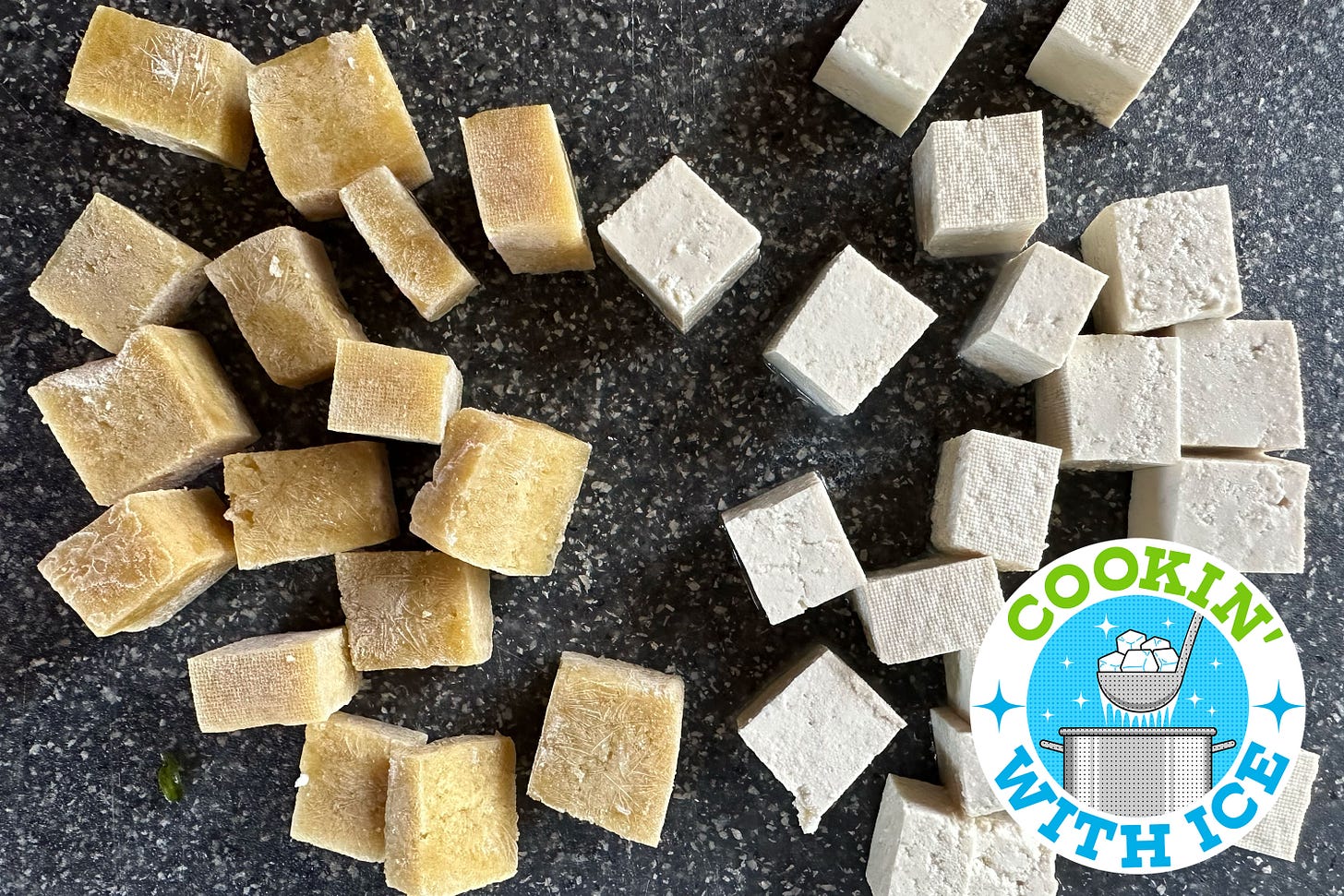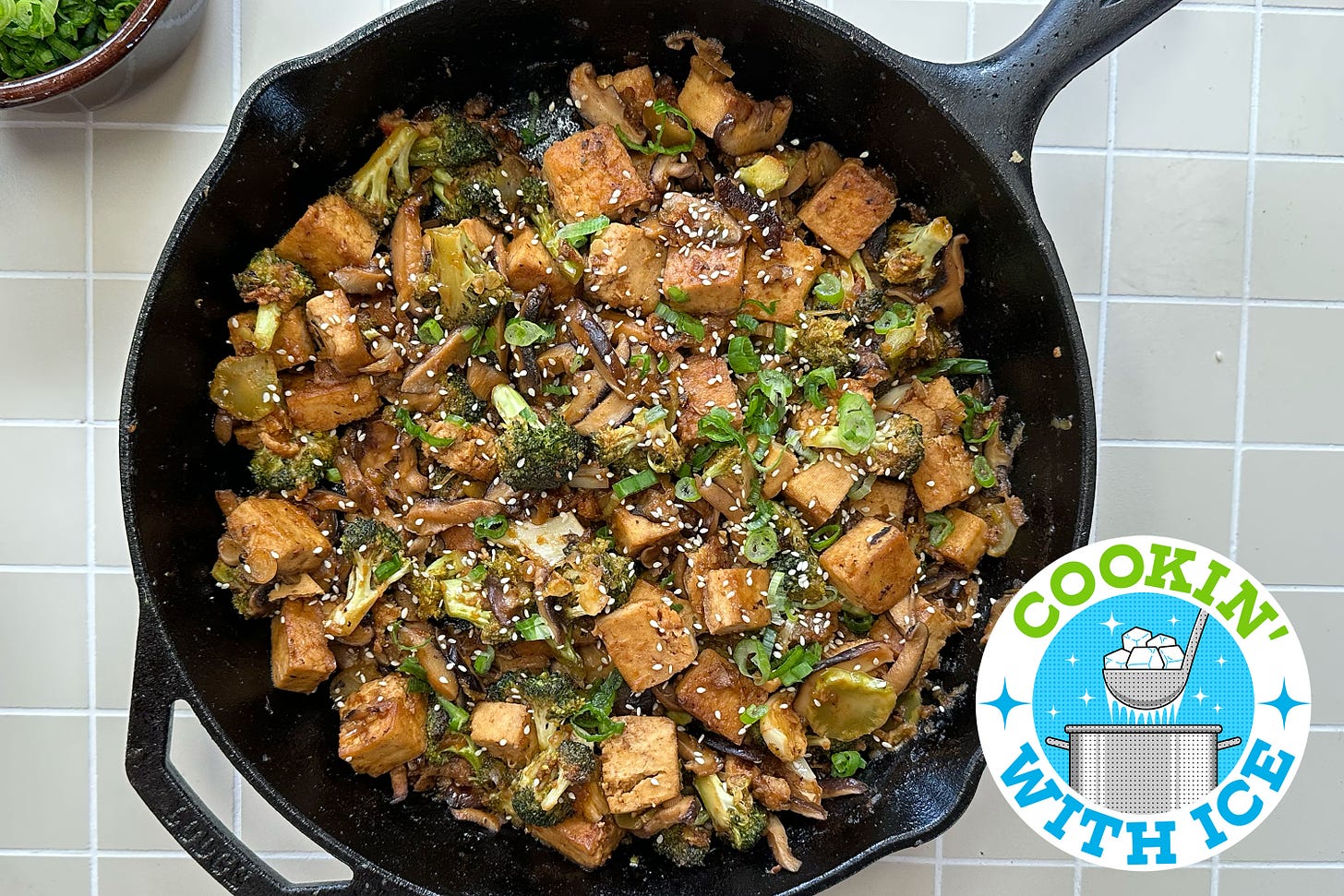The superpowered cooking gadget you already own
How to harness the tenderizing potential of ice
Everyone’s always looking for the next hot kitchen doodad—Instant Pots, air fryers, Foreman grills (any ’90s kids in the room?). But what those fads miss is that most homes already have one of the greatest prep tools of modern life: the freezer. Welcome to Cookin’ with Ice, a special series from Cool Beans. Over the next two weeks, we’re laying out everything a planet-conscious cook needs to know to prepare delicious and sustainable meals right out of the freezer.
A freezer is a superhero in the fight against food waste and a cheat code for quick weeknight dinners, but there’s also food-science magic to tap below 32 degrees, especially in a plant-forward kitchen. Freezing can make veggies better, which is where our chilling journey begins.
The great tenderizer
The freezer manipulates the texture and flavor of certain foods, which can be good or bad depending on what you’re throwing in there. Most fruits and veggies contain a lot of water that, when frozen, turns into ice crystals within the plant cells, ultimately changing the structure of the flesh. This is why watery produce like celery can get mushy after sitting on ice.
Other veggies actually improve in texture when you freeze them. Take stuffed cabbage: Most recipes instruct you to parboil the leaves to make them more pliable, but you can also freeze them to help break down the structure and keep the leaves from cracking when rolled. There’s also a technique called cryo-blanching, in which a rapid freeze and thaw tenderizes smaller or cut veggies—without materially hurting their color and flavor. It works great with green beans, asparagus, and peas.
Perhaps the best example of this, though, is the sweet potato. Freezing them before roasting yields a fluffier carb with a more concentrated sweetness. This “hack” goes viral on TikTok every now and again but it’s no fad: Street vendors in Northern China have long sold the extra-fluffy, extra-caramelized treats as a snack.
The process is easy enough:
Scrub, dry, and chuck a sweet tater in the freezer and leave it there for 6 hours.
Wrap it in foil and roast at 300 degrees for 2 hours.
Unwrap it and crank the heat to 450 for 45 minutes to an hour—until the skin’s fork-tender.
You’ll believe the hype from the moment the foil comes off at the 2-hour mark. Caramel-colored juices burst out of the skin. And after the final 45 minutes, the middle becomes super fluffy instead of stodgy and dense like the core of one cooked from room temp. Though there’s no huge flavor difference in the flesh, the skin is substantially sweeter than usual—it’s hard to quantify how much, scientifically speaking, but 10x seems fair.

There are a couple things going on here. Ice crystals inside rupture the cell walls of the flesh, but not the skin. Then, during roasting, those icy bits melt and become steam, which expands and breaks through the exterior, leaving a trail of gooey caramel-like juices. In the absence of all that water, the flesh gets super pillowy. Drastically lowering the sweet’s temperature before it hits the oven also allows an enzyme called amylase to work some flavor magic. Amylase, whose job is to break down carbs, is very active between the temps of 135 to 170, where a frozen-roasted spud lingers longer. At those temps, the enzyme converts starches into the simple (very sweet) sugar, maltose.
Though you’d think this technique would work for other starchy and thick-skinned tubers and roots, experiments we tried with regular russets and beets turned out to be duds. So save this trick for sweet spuds. That’s not to say we’ve hit the limits of freezer tenderizing. It’s also the secret to making a particular plant-based protein a lot more satisfying.
Turn tofu into the ultimate flavor sponge
Tofu may be a popular plant protein, but even its biggest fans know it’s hard to saturate those soy-based blocks with flavor, even after marinating. Unless you freeze them first. Tofu, like most plants and plant-based foods, contains a lot of water, so when those ice crystals expand they leave behind a porous sponge. That means iced tofu holds on to sauces and soaks up broth extremely well. Its texture is also chewier, bouncier, even meatier, and it holds its shape more than it would straight from the fridge.

This makes frozen tofu ideal for soups and braises. It’s also perfect for quick marinades and stir-frys, where you want maximum flavor absorption in minimum time. Our saucy bulgogi-inspired stir-fry features one of our favorite pantry flavor stars: gochujang chili paste.
First, let’s run through the basics of freezing those blocks:
Drain, dry, and cut the tofu—any kind works, but silken requires gentler handling—into your desired shape.
Freeze the pieces in a single layer until solid, 4 to 6 hours. It may turn yellow, but that’s fine.
Transfer to a sealed container, and store in the freezer for up to a year.
Thaw and drain any excess water with a kitchen towel before using.
Bulgogi Tofu, Broccoli, and Mushrooms
Serves 4 to 6






